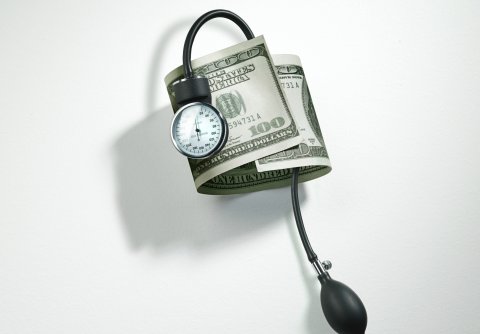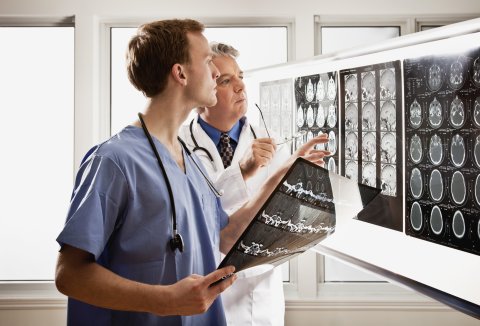HEATLH
The $1 Trillion Health Care Problem That's Jacking Up Americans' Medical BillsâAnd How You Can Fight It
In this excerpt from his new book, 'Get What's Yours for Health Care,' best-selling author Philip Moeller explains how too many tests, procedures and other care can lead to unneeded care and bad outcomesâand what steps you can take to get just the right level of care.


- "Most Americans remain poorly informed about the costs and benefits of particular treatments."
- "Many patients still seek tests or treatment even when informed that they are unlikely to yield much benefit, because they have been conditioned to fear rare, life-threatening events."
- "Many patients proceed with low-value treatment either because they distrust the evidence of its low value presented to them or because they suspect that the resources saved will only bolster an insurer's or provider's profit margins rather than benefit the public."

Choosing Wisely's 5 Questions to Ask Your Doctor
Accurate Diagnosis and Second Opinions
Sue Sheridan became a first-time mother more than 25 years ago. Her son was born in 1995. Like many newborns, he had jaundice. Unlike only a few others, he had a more serious condition that went undiagnosed by caregivers at her community hospital in Boise, Idaho.
"My son suffered brain damage from kernicterus [a rare form of brain damage in jaundiced newborns] that was not diagnosed to treat his newborn jaundice. [Jaundice is] very, very, very common," she said when I spoke with her late in 2019. "It's the most common newborn phenomenon. There are national guidelines out there. And nobody followed them. And he ended up with brain damage.
"A lot of patients don't even think about looking up guidelines," she said. "I wish I would have....That was in 1995. He now has severe cerebral palsy."
Sheridan's exposure to the effects of a missed medical diagnosis was not over. "After my son's effort, four years later my husband died because he had a tumor in his cervical spine that was removed. We were told it was benign.
"What we didn't learn," she continued matter-of-factly, "was that 23 days later a final pathology report came out. By now, he was discharged. And it was a malignant cancer, and that document never got presented to the neurosurgeon. It got put in my husband's file—his medical records. And the neurosurgeon never saw it, so his cancer went untreated for six months. And by the time the pain came back, it was too late. And so my husband died [three years later] when he was 45."
Enduring these devastating family tragedies triggered Sheridan to switch careers from international trade financing to health care and, in particular, patient safety. Sheridan looked deeply into what was being done to protect patients. "I thought somebody was in charge of keeping us safe," she said. "I learned that no one is in charge of keeping us safe."
Sheridan looked deeply into what was being done to protect patients. "None of the agencies [including the Food and Drug Administration (FDA), the Centers for Disease Control (CDC) and other groups] is tasked with keeping us safe," she said, lamenting the absence of a health care equivalent to the National Transportation Safety Board, which investigates accidents and identifies ways to prevent them. "We don't have that in health care."
Sheridan cofounded Consumers Advancing Patient Safety (CAPS), which eventually led to advocacy work with the World Health Organization. Since early 2018, she has been head of patient engagement at the Society to Improve Diagnosis in Medicine (SIDM).
Sheridan also fought to get a better deal for her family. She and her late husband, a physician, brought a malpractice action in 1997 related to their son and fought all the way to the Idaho Supreme Court. There the Sheridans won, triggering a substantial award to fund Cal's lifelong care.
After her husband's death, and with the knowledge learned during the grueling case involving her son, Sheridan settled out of court. "I just did not trust the system," she said in explaining her decision.
In addition to financial awards, Sheridan is proud that the actions over her son and her late husband's treatments included formal changes in hospital treatment policies. "Malpractice doesn't change the system," she said. "They wanted me to sign gag clauses and seal everything up, and I refused to do that. Diagnosis is the beginning of the journey, and the beginning of what we hope is the right treatment," Sheridan noted. "If you don't get the right diagnosis, you're getting the wrong treatment." - Do I need this test or procedure?
- What are the risks and side effects?
- Are there simpler, safer options?
- What happens if I don't do anything?
- How much does it cost, and will my insurance pay for it?
Vascular events (strokes, heart attacks, pulmonary embolisms and related circulatory conditions), infections (principally sepsis) and cancer are the three leading sources of misdiagnoses. The potentially deadly consequences of these events should put you and your personal health posse on high alert. Women and minorities need to be particularly alert to bias in their diagnoses. They have been routinely excluded from disease research studies and remain underrepresented. As a result, their symptoms may lead to erroneous diagnoses. A woman who presents in an emergency room setting with chest or back pain might be diagnosed with acid reflux or gastro esophageal reflux disease, Sheridan said. That might be true for men, but she could be having a heart attack. Gender bias is worse for African American women, who are at higher risk for stroke. Unless your doctor tells you your condition is life-threatening and requires immediate treatment, your initial response to a diagnosis involving serious conditions should include asking your provider what treatment they recommend, where it be performed and if there is a time it should begin. When decisions don't need to be made on the spot in an emergency room, don't rush things. "Thanks for providing your thoughts," you might say. "It's a lot to take in all at once. Would it be okay if I set up a follow-up appointment to discuss this further?" A diagnosis related to any serious medical problem should trigger an extensive and broadening circle of research among friends, medical professionals in your community, disease-specific sites, leading medical sites and social media advocacy groups. SIDM has a patient toolkit that can help prepare you for a deeper dive with your doctor. It's an interactive form you can complete and print out that asks you questions about your medical condition, symptoms and any related personal or family medical history, plus a list of your medications. It allows you to record pain issues. Bring a complete copy of your medical records and tell your doctor anything helpful. Lack of complete or accurate patient records is regularly cited as a contributing cause of medical misdiagnoses. Ask Choosing Wisely's 5 questions (see above), and ask some care questions from SIDM's toolkit below.
Your doctor recommends additional tests. Now what?
Here are some follow-up questions to ask from SIDM's toolkit:
A variant of this sequence applies when the misdiagnosis may consist of the absence of a diagnosis—a missed call of an illness or condition. Doctors face much tougher medical issues than they once did, simply because the things that medicine now can treat have expanded, as have the tools and medicines for treatment.
"The explosive growth in medical evidence and new technologies ends up being a double-edged sword," the SIDM site notes, "making diagnosis more accurate but also more complex at the same time."
If your doctor or your child's doctor feels a health condition is not serious—"She just has the flu"—you should follow up with the "what else might it be" or "what's the worst it could be" question. Your doctor needs to hear your concerns, and in thinking about how to reply, they just might change their opinion and do you and your child a lot of good.
Health reforms in Washington seem to be the only ones that get broad attention. But important reforms in the delivery of health care happen all the time, albeit at a less headline-generating pace. Evidence-based tools to spot the care you need and the care you don't are great examples of how people can make informed health decisions. In the process, they can achieve better health outcomes and often spend a lot less money on their care.
Here are some follow-up questions to ask from SIDM's toolkit:
- What is my diagnosis? What else could it be? And what's the worst it could be?
- Why do you think this is my diagnosis? From test results? From my physical exam?
- Can you give me written information on my diagnosis? A pamphlet? A website?
- Can you explain the test/treatment you want me to have?
- What are the risks to the test/treatment you want me to have? What happens if I do nothing?
- When do I need to follow up with you?
- What should I do if my symptoms worsen or change, or I don't respond to treatment?
- Can you suggest a specialist who treats the condition you've diagnosed? I would like to make an appointment with them. (This one is mine, not from SIDM)
Get What's Yours Rx
> Up to a third of all medical care is unneeded.
> Use "Choosing Wisely" to spot unneeded care.
> Learn how to spot bad medical diagnoses, which kill as many people as cars or guns.
> Your doctors aren't perfect, so talk to them about suspect care recommendations.
> Ask your doctors informed questions and use good checklists of things to cover.
→ From Get What's Yours for Healthcare: How to Get the Best Care at the Right Price by Philip Moeller. Copyright © 2021 by Philip Moeller. Reprinted by permission of Simon & Schuster, Inc.
> Up to a third of all medical care is unneeded.
> Use "Choosing Wisely" to spot unneeded care.
> Learn how to spot bad medical diagnoses, which kill as many people as cars or guns.
> Your doctors aren't perfect, so talk to them about suspect care recommendations.
> Ask your doctors informed questions and use good checklists of things to cover.
Request Reprint & Licensing
Submit Correction
View Editorial Guidelines
To read how Newsweek uses AI as a newsroom tool, Click here.


